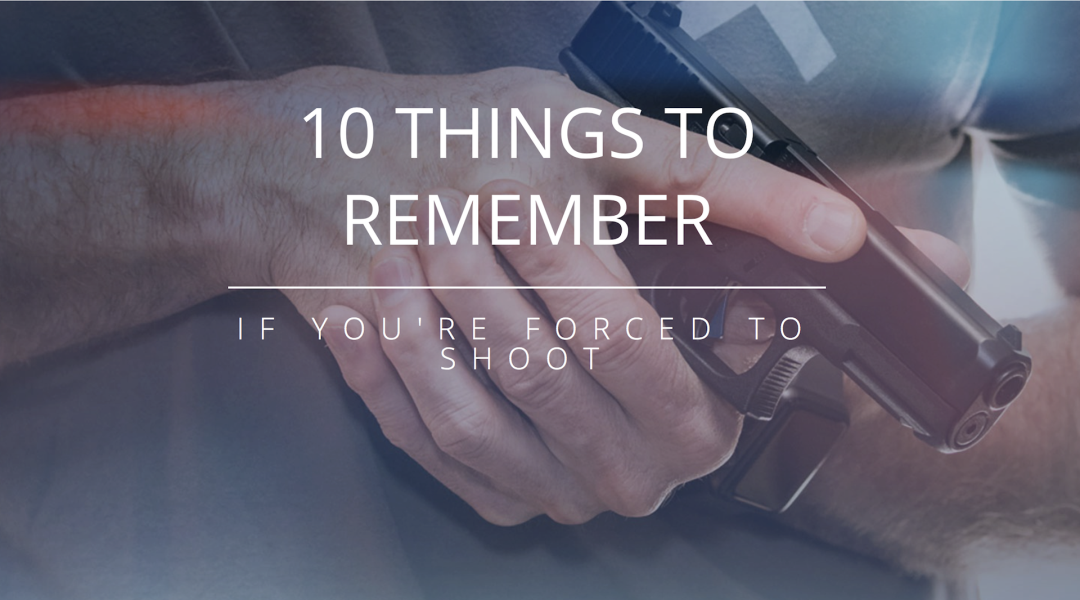
Posted on July 9, 2018
What to Do in a Lawful Self-Defense Incident
WHAT NEXT? WHAT TO DO AFTER A SELF-DEFENSE SHOOTING
10 Things to Remember if You’re Forced to Shoot
Stan Campbell, Co-Founder and COO of CCW Safe, talks about 10 things to remember if you are involved in a self-defense shooting. Stan spent over 20 years as a police officer in Oklahoma City, retiring as a lieutenant in charge of a street crime team. He also served over a decade on the Tactical Unit (SWAT) and has trained more than 4,000 police officers and citizens as an instructor in self-defense, use of force and de-escalation techniques.
1. Make Sure You Are Safe: First and foremost, ensure you are safe from any threat, i.e. verify that the suspect no longer poses a risk. Visually ascertain that the suspect no longer has access to a weapon, and scan for other suspects. Do not approach the suspect or move/touch evidence.
2. BE THE FIRST TO CALL 911: Even if you do not pull the trigger, be the first to call 911. If the incident was serious enough for you to deploy your firearm, make a report as soon as possible, while the details are still clear in your mind. Remember – police officers commonly identify the first person who calls as the victim.
3. INITIATE EMERGENCY RESPONSE: From a safe position or location, call 911. Request emergency medical services if they are needed for you, the suspect or others. Describe what you are wearing, and let the dispatcher know you will not have your weapon in your hand when the officers arrive. Tell the 911 operator something similar to, “I had to use the weapon in self-defense,” “I was forced to defend myself,” “I was in fear for my life,” or “I was attacked.” Do not give a detailed account of the incident. This is not the time.
4. PREPARE FOR RESPONDING OFFICERS: When you see police cars or officers getting close, or hear their sirens, holster your weapon. Officers responding to a shooting incident often have a heightened level of concern for their safety, so be prepared to follow their directions. Raise your empty hands above your head with the palms face forward, and listen to their commands. They will disarm you and may handcuff you.
Again, this is not the time to hand reporting police officers your CCW Safe card nor mention you have a legal service plan for self-defense shootings. Keep words to a minimum and focus on following the directions of the officers.
5. YOUR INITIAL RESPONSE MATTERS: Remember that your defense begins with you. What you say and do at this point can make or break your case if you later find yourself in a defensive position. Although you should provide initial information to the responding officers, it is still not the time to give a detailed statement. You might say something like, “I was forced to defend my life,” or “That is the suspect. He attacked me.” If you are asked to give a detailed statement, voice your intent to cooperate, but add, “I want to give a full statement, but in the presence of my attorney.”
6. IDENTIFY CASE ELEMENTS TO OFFICERS: Be aware that what you DON’T say might hurt your case if litigation eventuates from the incident. Officers need a few case elements – basic facts pertinent to the incident – to present to the investigators. Examples of basic case element statements are, “That is the suspect, and the weapon he pulled on me is there,” or “That person is a witness.” At this point, it is again not the time to provide a detailed statement.
7. INFORM OFFICERS OF INJURIES: Inform police officers of any injuries you may have sustained, and make sure that these are documented before you are cleaned up. If you are injured in any way, request to be taken to the hospital for evaluation. This is not the time to be macho, because your injuries can be presented to support your decision to use deadly force. Remember also that just because you are not bleeding, this doesn’t mean you haven’t sustained any injuries. Have yourself examined and checked for internal injuries you may not even realize you have.
Often, traumatic incidents can result in an adrenaline overload that temporarily overshadows the sensation of pain associated with an injury. This is actually a physiologically based human survival mechanism which serves the purpose of supporting the “fight or flight” response in the face of a life-threatening situation.
8. CONTROL THE INFORMATION ABOUT THE INCIDENT: Although you may feel the need to talk about the traumatic incident and/or the fear it generated, don’t write or talk about it on social media. Furthermore, don’t share information about it to family or friends through any electronic device. While at the scene, don’t exchange stories with witnesses or news personnel, and do not make off-color comments or laugh at the jokes of others.
9. PROVIDE IDENTIFYING INFORMATION ONLY: Explain to law enforcement personnel that you would like to give a full statement and interview in the presence of your attorney. Provide the responding officers your basic identifying information only. Request to notify your legal representative. Get ahold of your emergency contacts and request that they notify CCW Safe immediately of the emergency.
10. If you are a member of a legal service, keep that information close: If you carry a concealed weapon, no matter how frequently, it is extremely important to belong to a legal service plan. When armed with your concealed weapon, be especially alert and safe. If a situation arises that creates fear of threat, assess it carefully and ask yourself, “If I didn’t have a weapon on me at this time, what would I do?” This one question could keep you from being launched into a traumatic incident that might change your life irrevocably.